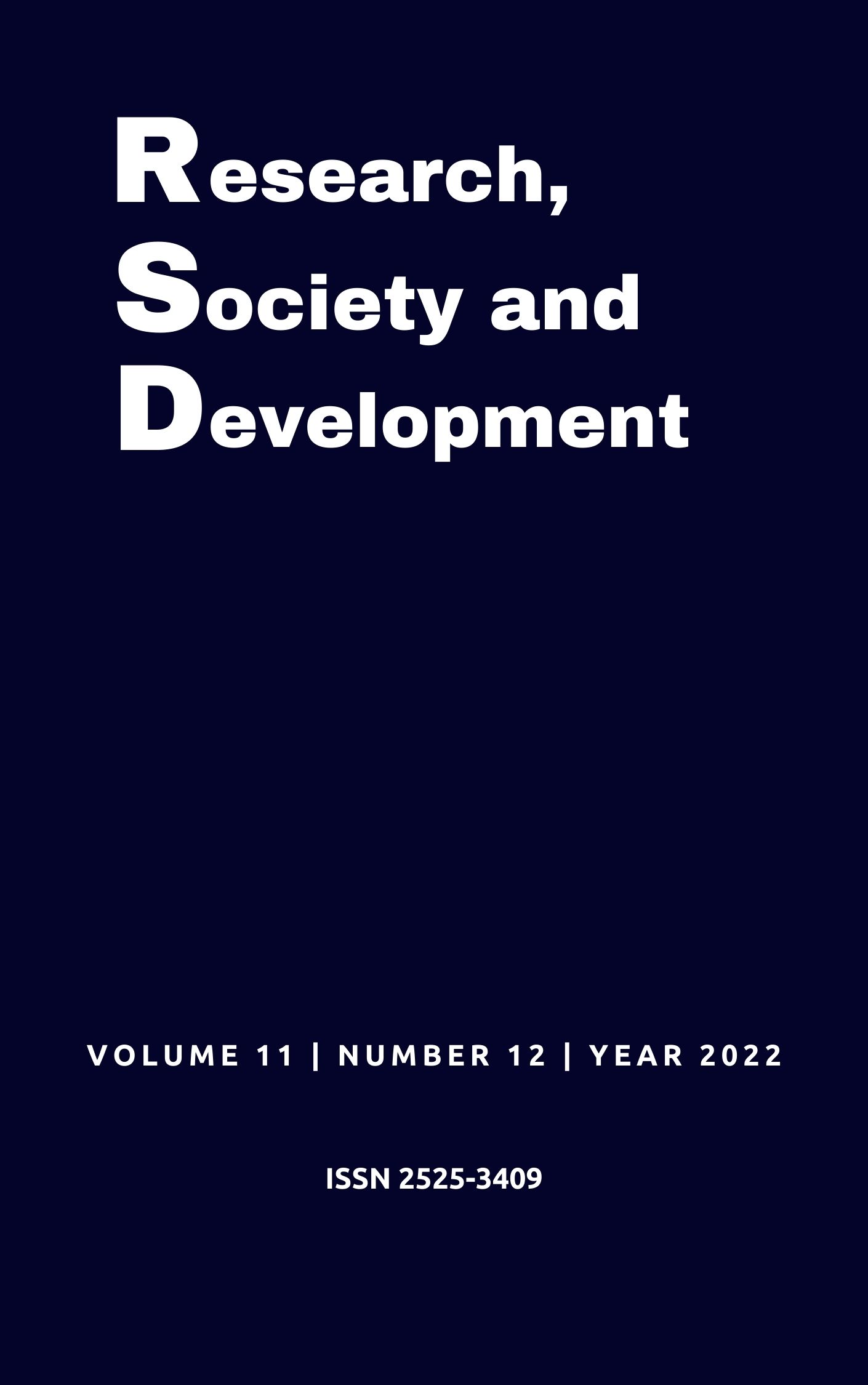Implementação de uma farinha produzida à base de couve manteiga (Brassica oleracea) em alimentos salgados para suplementação de fibras alimentícias
DOI:
https://doi.org/10.33448/rsd-v11i12.34191Palavras-chave:
Análises físico-químicas, Análise sensorial, Hortaliças, Fibras alimentares.Resumo
Para uma dieta saudável é necessária a quebra de alguns tabus alimentares e enriquecendo do cardápio de forma barata e viável. No entanto, esta informação encontra-se muito pouco disponível à população de baixa renda. A couve-manteiga é uma hortaliça de fácil acesso e baixo custo que contém diversas vitaminas, minerais e fibras alimentares, as quais auxiliam no funcionamento do intestino, combatem o diabetes e diminuem o colesterol. Desse modo, o objetivo do presente trabalho foi a utilização dessa hortaliça em torta salgada para suplementação de fibras alimentícias. Para isso, foram produzidas 4 tortas com diferentes concentrações de farinha de couve: (1) tradicional, (2) com 0,24 g/100g, (3) com 0,36 g/100g e (4) com 0,48 g/100g, sendo essas proporções suficientes para alteração no teor de fibras das tortas. A análise sensorial foi realizada por 100 julgadores não treinados, os quais avaliaram a aceitação (aroma, textura, sabor, aparência e impressão geral) utilizando escala hedônica de 9 pontos (1=desgostei muitíssimo, 9=gostei muitíssimo) e a intenção de compra com escala de 5 pontos (1=certamente não compraria, 5=certamente compraria). Não houve efeito da adição de couve na aparência, textura e impressão geral (p > 0,05) das tortas, independentemente da concentração. A adição de 0,48 g/100g de couve possibilitou uma melhoria no aroma dos produtos (p ≤ 0,05). Por fim, a adição de couve melhorou o sabor das tortas (p ≤ 0,05), independentemente da concentração. Com relação ao teor de fibras obtidos por análise centesimal, a torta tradicional apresentou 3,15%, enquanto a torta 4, com maior concentração de couve, apresentou 5,39%. Dessa maneira, uma pequena adição de couve a um alimento salgado já é responsável pelo aumento no teor de fibras alimentares. Conclui-se, então, que a adição de couve melhorou a aceitação das tortas pelos consumidores, sendo uma opção viável para aplicação em tortas salgadas.
Referências
Bernaud, F. S. R; & Rodrigues, T. C. (2013) Fibra alimentar – Ingestão adequada e efeitos sobre a saúde do metabolismo. Arq Bras Endocrinol Metab 57(6): 397-405. http://dx.doi.org/10.1590/S0004-27302013000600001
Bobbio, F.O.; & Bobbio, P.A. (2003) Introdução à química de alimentos. (3a ed.), Varella, 237 p.
Boerjan, W.; Ralph, J.; Baucher, M. (2003) Lignin biosynthesis. Annual Reviews of Plant Biology. 54(1), 519-46.
Buckeridge, M. S. & Tiné, M.A.S. (2001). Composição polissacarídica: estrutura da parede celular e fibra alimentar. In: Lajolo, M. F. et al. (2001). Fibra dietética in Iberoamérica: tecnologia y salud. Obtención, caracterizacion, efeito fisiológico y aplication en alimentos. São Paulo: Varella. p. 43-60
Dreher, M. L; & Sungsoo, M. L. (2001) Dietary fiber overview. Handbook of dietary fiber, Marcel Dekker, Inc, New York, pp. 1-16.
FDA- Food and Drug Administration. (1998) Center for Food Safety & Applied. Nutrition. A good labelling guide: appendix C Health Claims. 1998.
Gava, A. J. (2007) Princípios da Tecnologia de Alimentos. Nobel, São Paulo.
Gavanski, D. S.; Baratto, I.; & Gatti, R. R. (2015) Avaliação do hábito intestinal e ingestão de fibras alimentares em uma população de idosos. Rev Bras Obesidade Nutr Emagrecim; 9(49): 3-11.
Gondim, J. A. M.; Moura, M. D. F. V.; Dantas, A. S.; Medeiros, R. L. S.; & Santos, K. M. (2005) Composição centesimal e de minerais em cascas de frutas. Food Science and Technology, 25(4), 825-827.
Haard, N.F. (1993) Caracteristicas de los tecidos vegetales comestibles. In: FENNEMA, O.R. Química de los alimentos. Zaragoza: Acribia, p. 961-1022.
Jiménez-Escrig, A.; Rincón, M.; Pulido, R.; & Saura-Calixto, F.(s.d.) Guava Fruit (Psidium guajava L.) as a New Source of Antioxidant Dietary Fiber. J. Agric. Food Chem. ACS Publications.
Rocha, D. R. C. et al. (2008) Macarrão adicionado de ora-pro-nóbis (Pereskia Aculeata Miller) desidratado. Alim. Nutr, Araraquara: UFVJM, 19(4), 459-465,
Silva, G. M.; Durante, E. B.; Assumpção, D.; Barros, M. B. A.; Corona, L. P. (2019) Elevada prevalência de inadequação do consumo de fibras alimentares em idosos e fatores associados: um estudo de base populacional. Revista Brasileira de Epidemologia. Scielo. https://doi.org/10.1590/1980-549720190044
Downloads
Publicado
Edição
Seção
Licença
Copyright (c) 2022 Geovane Aparecido Ramos da Silva; Victor Hugo Maldonado da Cruz; Patrícia Daniele Silva dos Santos; Patrícia Magalhães de Souza; Guilherme Roque Zidiotti; Arthur Marroni Pereira; Ana Paula Lourenção Zomer; Eloize Silva Alves; Cintia Stefhany Ripke Ferreira; Nathalia Elias Borges; Jéssica de Souza Alves ; Giovana Frigo; Oscar de Oliveira Santos Junior

Este trabalho está licenciado sob uma licença Creative Commons Attribution 4.0 International License.
Autores que publicam nesta revista concordam com os seguintes termos:
1) Autores mantém os direitos autorais e concedem à revista o direito de primeira publicação, com o trabalho simultaneamente licenciado sob a Licença Creative Commons Attribution que permite o compartilhamento do trabalho com reconhecimento da autoria e publicação inicial nesta revista.
2) Autores têm autorização para assumir contratos adicionais separadamente, para distribuição não-exclusiva da versão do trabalho publicada nesta revista (ex.: publicar em repositório institucional ou como capítulo de livro), com reconhecimento de autoria e publicação inicial nesta revista.
3) Autores têm permissão e são estimulados a publicar e distribuir seu trabalho online (ex.: em repositórios institucionais ou na sua página pessoal) a qualquer ponto antes ou durante o processo editorial, já que isso pode gerar alterações produtivas, bem como aumentar o impacto e a citação do trabalho publicado.


